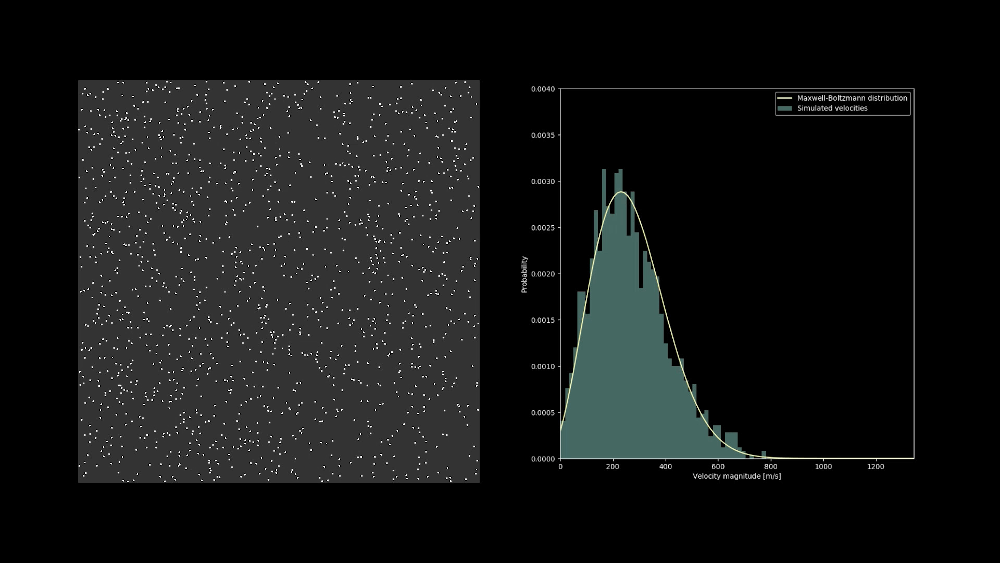» Visualizing the velocity distribution of a hard sphere gas
March 24, 2020 at 21:42 | | 2020_0 | Adrian KummerländerThe velocity distribution of a system of colliding hard sphere particles quickly evolves into the Maxwell-Boltzmann distribution. One example of this surprisingly quick process can be seen in the following video:
» Visualize the sky for arbitrary time and space coordinates on earth
January 11, 2020 at 21:12 | firmament | 071bc3 | Adrian KummerländerThe primary color of the sky is caused by Rayleigh and Mie scattering of light in the atmosphere. While attending the lecture on Mathematical Modelling and Simulation at KIT I implemented a ray marcher to visualize this. Together with a model for calculating the sun direction for given coordinates and times this allows for generating interesting plots:
For more details check out Firmament.
» Started working on a framework for generating LBM kernels
October 27, 2019 at 22:35 | | 2019_1 | Adrian KummerländerDuring the past exam season I now and then continued to play around with my GPU LBM code symlbm_playground. While I mostly focused on generating various real-time visualizations using e.g. volumetric ray marching, the underlying principle of generating OpenCL kernels from a symbolic description has not lost its promise.
This is why I have now started to extract the generator part of this past project into a more general framework. Currently boltzgen targets C++ and OpenCL using a shared symbolic description while providing various configuration options:
λ ~/p/d/boltzgen (boltzgen-env) ● ./boltzgen.py --help usage: boltzgen.py [-h] --lattice LATTICE --layout LAYOUT --precision PRECISION --geometry GEOMETRY --tau TAU [--disable-cse] [--functions FUNCTIONS [FUNCTIONS ...]] [--extras EXTRAS [EXTRAS ...]] language Generate LBM kernels in various languages using a symbolic description. positional arguments: language Target language (currently either "cl" or "cpp") optional arguments: -h, --help show this help message and exit --lattice LATTICE Lattice type (D2Q9, D3Q7, D3Q19, D3Q27) --layout LAYOUT Memory layout ("AOS" or "SOA") --precision PRECISION Floating precision ("single" or "double") --geometry GEOMETRY Size of the block geometry ("x:y(:z)") --tau TAU BGK relaxation time --disable-cse Disable common subexpression elimination --functions FUNCTIONS [FUNCTIONS ...] Function templates to be generated --extras EXTRAS [EXTRAS ...] Additional generator parameters
The goal is to build upon this foundation to provide an easy way to generate efficient code using a high level description of various collision models and boundary conditions. This should allow for easy comparision between various streaming patterns and memory layouts.
» Symbolically generate D3Q19 OpenCL kernel using SymPy
June 15, 2019 at 20:45 | symlbm_playground | d71fae | Adrian KummerländerMy recent experiments in using the SymPy CAS library for automatically deriving optimized LBM codes have now evolved to the point where a single generator produces both D2Q9 and D3Q19 OpenCL kernels.
Automatically deriving kernel implementations from the symbolic formulation of e.g. the BGK relaxation operator presents itself as a very powerful concept. This could potentially be developed to the point where a LBM specific code generator could produce highly optimized GPU programs tailored to arbitrary simulation problems.
» Experimental visualization of the velocity curl
April 28, 2019 at 12:53 | compustream | ecaf66 | Adrian KummerländerCalculating the curl of our simulated velocity field requires an additional compute shader step. Handling of buffer and shader switching depending on the display mode is implemented rudimentarily for now. Most of this commit is scaffolding, the actual computation is more or less trivial:
const float dxvy = (getFluidVelocity(x+1,y).y - getFluidVelocity(x-1,y).y) / (2*convLength); const float dyvx = (getFluidVelocity(x,y+1).x - getFluidVelocity(x,y-1).x) / (2*convLength); setFluidExtra(x, y, dxvy - dyvx);
This implements the following discretization of the 2d curl operator:
Let be the simulated velocity field at discrete lattice points spaced by . We want to approximate the -component of the curl for visualization:
As we do not possess the actual function but only its values at a set of discrete points we approximate the two partial derivatives using a second order central difference scheme:
Note that the scene shader does some further rescaling of the curl to better fit the color palette. One issue that irks me is the emergence of some artefacts near boundaries as well as isolated “single-cell-vortices”. This might be caused by running the simulation too close to divergence but as I am currently mostly interested in building an interactive fluid playground it could be worth it to try running an additional smoothening shader pass to straighten things out.
» Add basic physical scaling and Knudsen quality criterion
April 16, 2019 at 22:45 | compustream | fc02e4 | Adrian KummerländerThe paper Automatic grid refinement criterion for lattice Boltzmann method by Lagrava et al. describes a criterion for measuring the local simulation quality using a comparison of the theoretical Knudsen number and the quotient of the cells’s non-equilibrium and equilibrium function.
While this criterion was developed to enable automatic selection of areas to be refined, it also offers a interesting and unique perspective on the fluid structure.
As the criterion requires calculation of the modeled Reynolds-, Mach- and Knudsen-numbers I took the time to set up the basics for scaling the simulation to actually model a physical system. Or rather calculating which physical model is represented by the chosen resolution and relaxation time.

